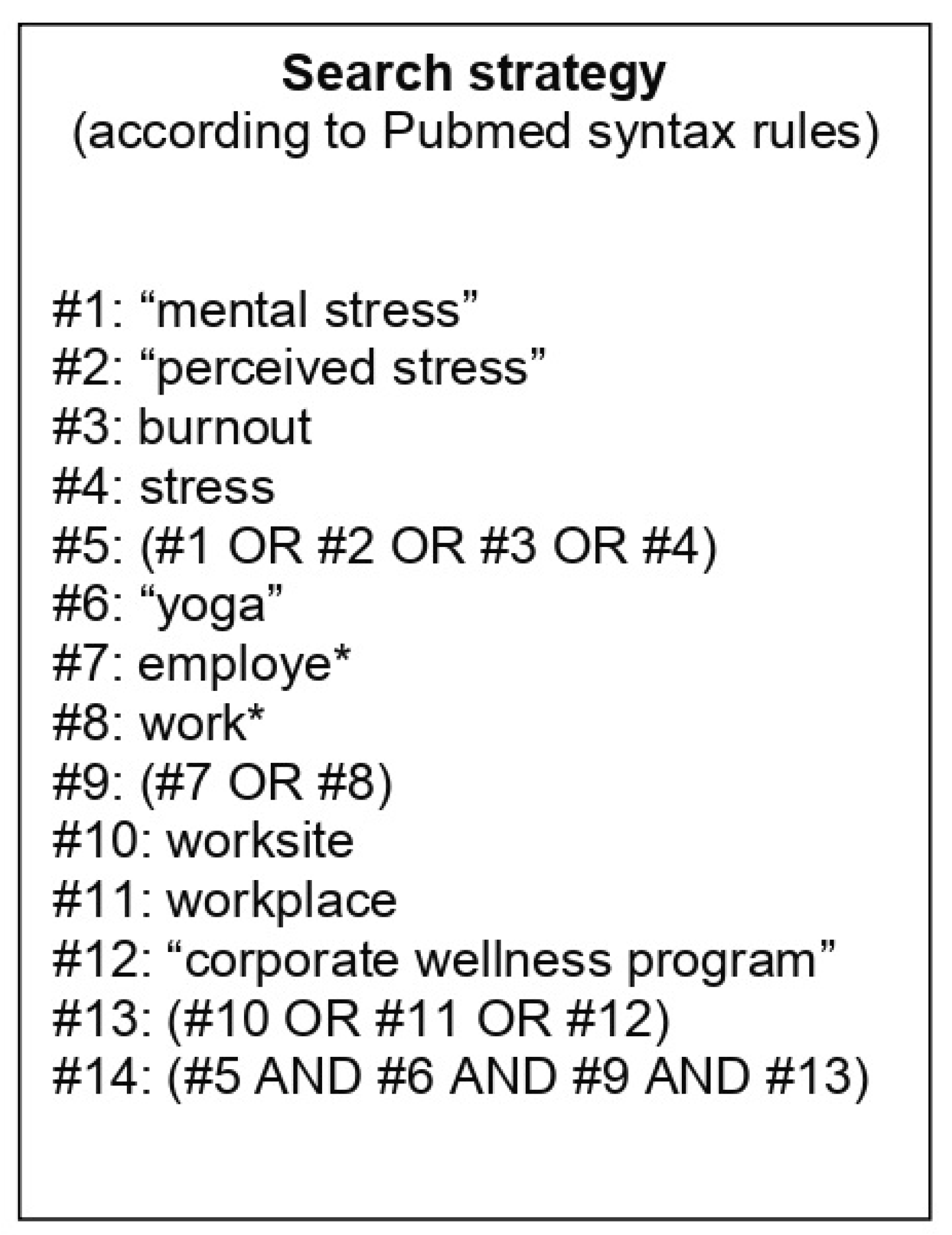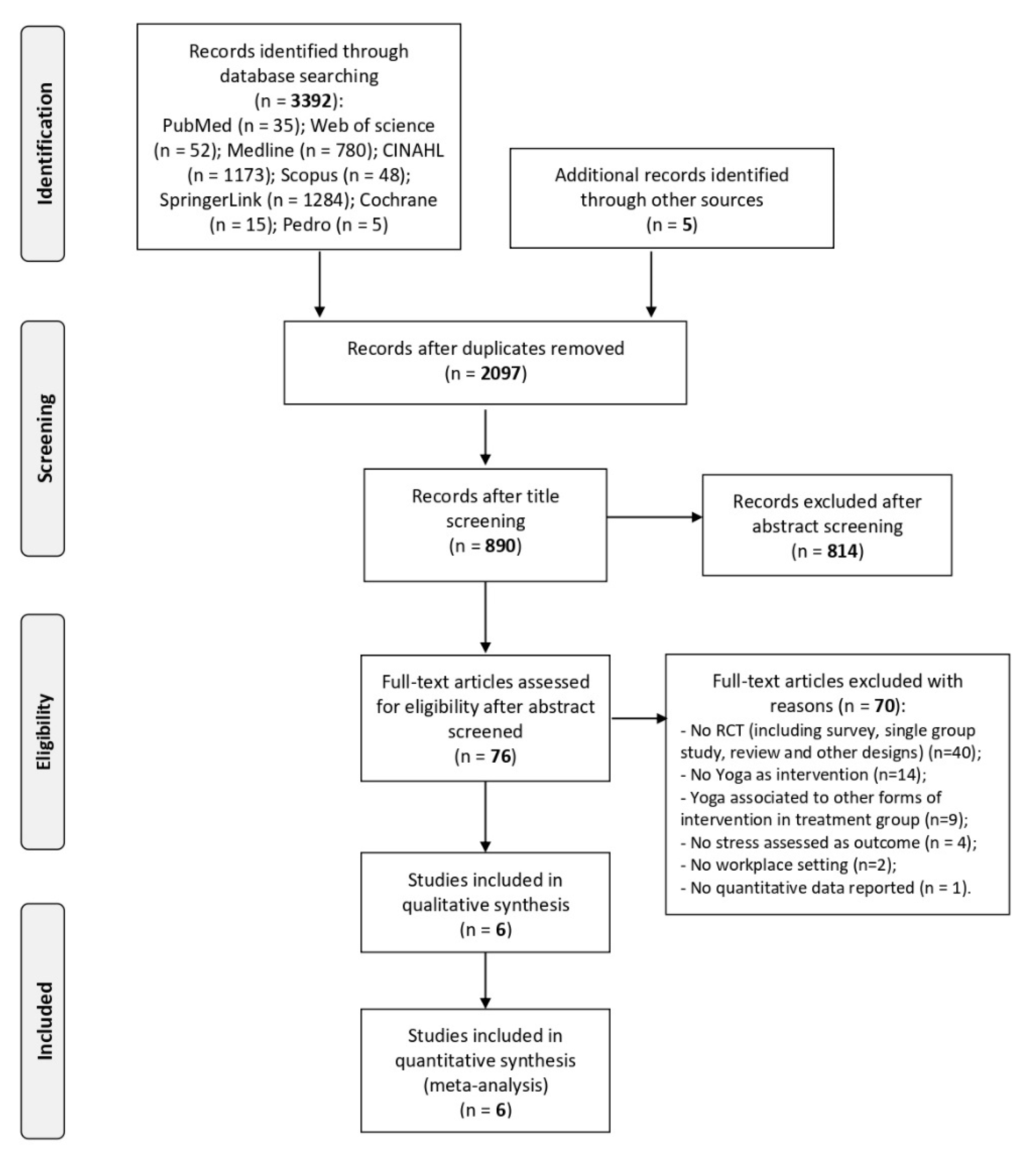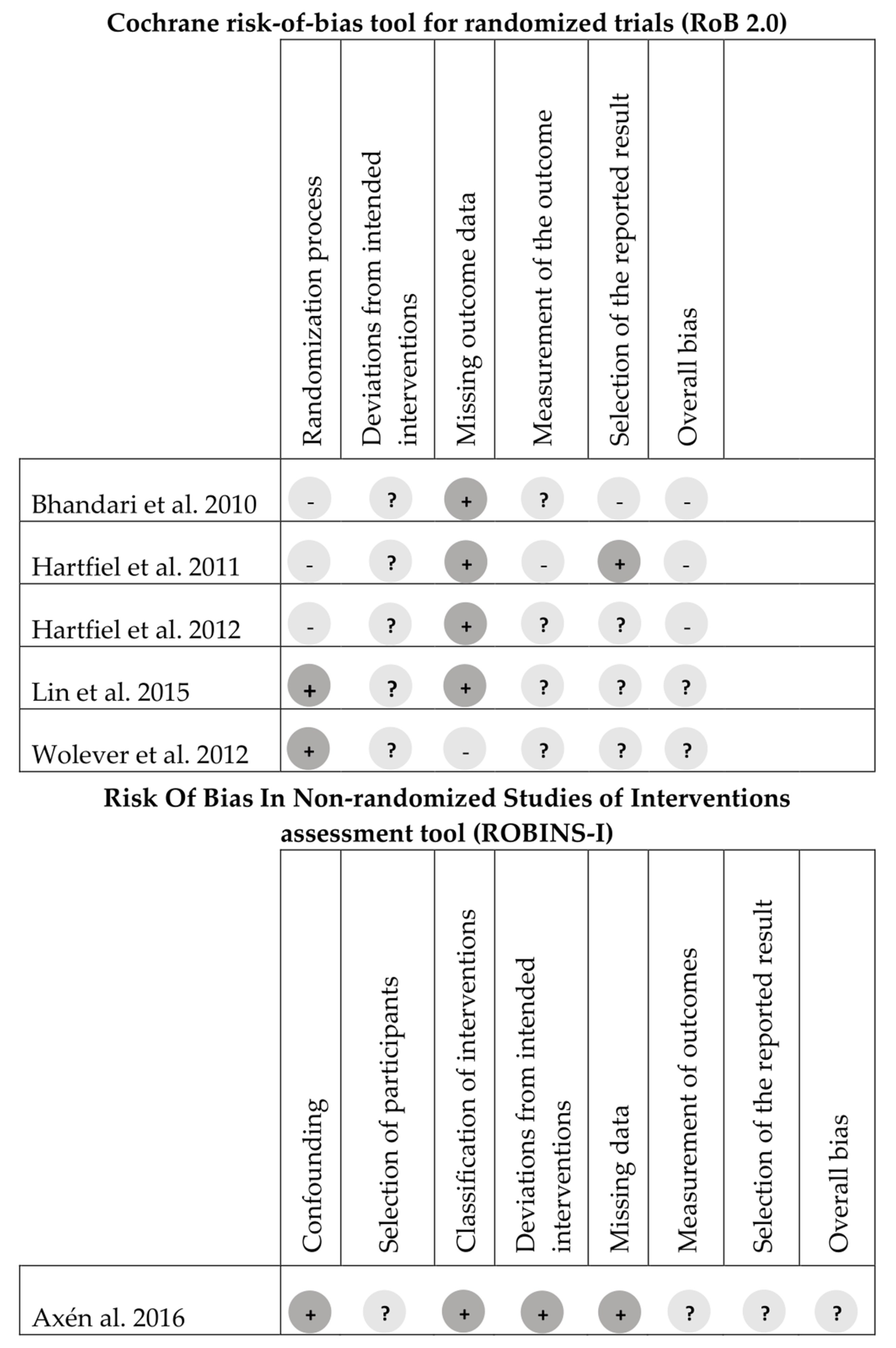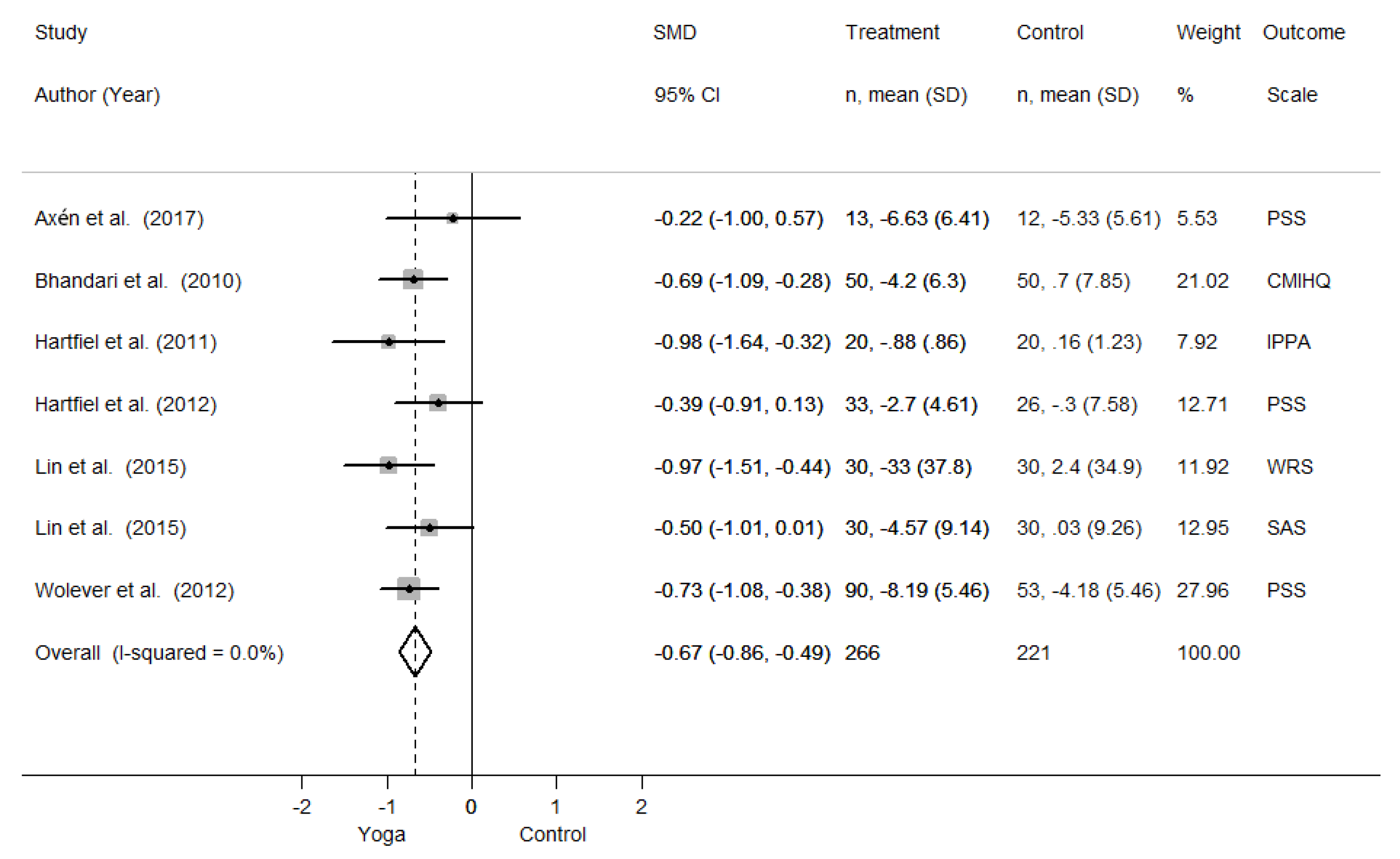Effectiveness of Workplace Yoga Interventions to Reduce Perceived Stress in Employees: A Systematic Review and Meta-Analysis
Abstract
1. Introduction
2. Materials and Methods
2.1. Data Sources and Searches
2.2. Study Selection
2.3. Data Extraction and Quality Assessment
2.4. Statistical Analysis
3. Results
3.1. Search Results
3.2. Study Characteristics
3.3. Risk of Bias Assessment
3.4. Quantitative Analysis
4. Discussion
5. Conclusions
Author Contributions
Funding
Conflicts of Interest
References
- Irastorza, X.; Milczarek, M.; Cockburn, W. Second European Survey of Enterprises on New and Emerging Risks, 2nd ed.; UK Data Service. SN: 7808; European Agency for Safety and Health at Work, TNS Infratest Sozialforschung: Munich, Germany, 2016. [Google Scholar] [CrossRef]
- Kivimaki, M.; Nyberg, S.T.; Batty, G.D.; Fransson, E.I.; Heikkila, K.; Alfredsson, L.; Bjorner, J.B.; Borritz, M.; Burr, H.; Casini, A.; et al. Job strain as a risk factor for coronary heart disease: A collaborative meta-analysis of individual participant data. Lancet 2012, 380, 1491–1497. [Google Scholar] [CrossRef]
- Eijckelhof, B.H.W.; Huysmans, M.A.; Garza, J.L.B.; Blatter, B.M.; van Dieen, J.H.; Dennerlein, J.T.; van der Beek, A.J. The effects of workplace stressors on muscle activity in the neck-shoulder and forearm muscles during computer work: A systematic review and meta-analysis. Eur. J. Appl. Physiol. 2013, 113, 2897–2912. [Google Scholar] [CrossRef] [PubMed]
- Bacil, E.D.A.; Mazzardo Júnior, O.; Rech, C.R.; Legnani, R.F.D.S.; De Campos, W. Physical activity and biological maturation: A systematic review. Rev. Paul. Pediatr. Sao Paulo Pediatric Soc. 2015, 33, 114–121. [Google Scholar] [CrossRef] [PubMed]
- Hassard, J.; Teoh, K.; Cox, T.; Cosmar, M.; Gründler, R.; Flemming, D.; Cosemans, B.; van den Broek, K. Calculating the Cost of Work-Related Stress and Psychosocial Risks—A Literature Review; Publications Office of the European Union: Luxembourg, 2014. [Google Scholar]
- LaMontagne, A.D.; Keegel, T.; Vallance, D. Protecting and promoting mental health in the workplace: Developing a systems approach to job stress. Health Promot. J. Aust. 2007, 18, 221–228. [Google Scholar] [CrossRef]
- Assmann, G.; Buono, P.; Daniele, A.; della Valle, E.; Farinaro, E.; Ferns, G.; Krogh, V.; Kromhout, D.; Masana, L.; Merino, J.; et al. Functional foods and cardiometabolic diseases. International Task Force for Prevention of Cardiometabolic Diseases. Nutr. Metab. Cardiovasc. Dis. 2014, 24, 1272–1300. [Google Scholar] [CrossRef]
- Minich, D.M.; Bland, J.S. Personalized lifestyle medicine: Relevance for nutrition and lifestyle recommendations. Sci. World J. 2013, 2013, 129841. [Google Scholar] [CrossRef]
- Sonnentag, S.; Jelden, S. Job Stressors and the Pursuit of Sport Activities: A Day-Level Perspective. J. Occup. Health Psychol. 2009, 14, 165–181. [Google Scholar] [CrossRef]
- Della Valle, E.; Sirico, F.; Cacciatore, F.; Palermi, S.; Marcantonio, R.; Spera, R. Worksite energy cost assessment in non-surgical versus surgical medical residency programs. Int. J. Occup. Environ. Med. 2019, 10, 216–217. [Google Scholar] [CrossRef]
- Corrado, B.; Ciardi, G.; Fortunato, L.; Iammarrone, C. Burnout syndrome among Italian physiotherapists: A cross-sectional study. Eur. J. Physiother. 2019, 21, 240–245. [Google Scholar] [CrossRef]
- Biffi, A.; Fernando, F.; Adami, P.E.; Messina, M.; Sirico, F.; di Paolo, F.M.; Coluccia, R.; Borghi, C.; Dascenzi, F.; Volpe, M. Ferrari Corporate Wellness Program: Results of a Pilot Analysis and the “Drag” Impact in the Workplace. High Blood Press. Cardiovasc. Prev. 2018, 25, 261–266. [Google Scholar] [CrossRef]
- Sirico, F.; Fernando, F.; di Paolo, F.M.; Adami, P.E.; Signorello, M.G.; Sannino, G.; Bianco, A.; Cerrone, A.; Baioccato, V.; Filippi, N.; et al. Exercise stress test in apparently healthy individuals—Where to place the finish line? The Ferrari corporate wellness programme experience. Eur. J. Prev. Cardiol. 2019, 26, 731–738. [Google Scholar] [CrossRef] [PubMed]
- Burn, N.L.; Weston, M.; Maguire, N.; Atkinson, G.; Weston, K.L. Effects of Workplace-Based Physical Activity Interventions on Cardiorespiratory Fitness: A Systematic Review and Meta-Analysis of Controlled Trials. Sports Med. 2019, 49, 1255–1274. [Google Scholar] [CrossRef] [PubMed]
- Prieske, O.; Dalager, T.; Herz, M.; Hortobagyi, T.; Sjogaard, G.; Sogaard, K.; Granacher, U. Effects of Physical Exercise Training in the Workplace on Physical Fitness: A Systematic Review and Meta-analysis. Sports Med. 2019, 49, 1903–1921. [Google Scholar] [CrossRef] [PubMed]
- Botha, E.; Gwin, T.; Purpora, C. The effectiveness of mindfulness based programs in reducing stress experienced by nurses in adult hospital settings: A systematic review of quantitative evidence protocol. Int. J. Evid. Based Healthc. 2015, 13, 21–29. [Google Scholar] [CrossRef] [PubMed]
- Elder, C.; Nidich, S.; Moriarty, F.; Nidich, R. Effect of Transcendental Meditation on Employee Stress, Depression, and Burnout: A Randomized Controlled Study. Perm. J. 2014, 18, 19–23. [Google Scholar] [CrossRef]
- Woodyard, C. Exploring the therapeutic effects of yoga and its ability to increase quality of life. Int. J. Yoga 2011, 4, 49. [Google Scholar] [CrossRef]
- Williams, K.; Steinberg, L.; Petronis, J. Therapeutic Application of Iyengar Yoga for Healing Chronic Low Back Pain. Int. J. Yoga Ther. 2003, 13, 55–67. [Google Scholar]
- Teisala, T.; Mutikainen, S.; Tolvanen, A.; Rottensteiner, M.; Leskinen, T.; Kaprio, J.; Kolehmainen, M.; Rusko, H.; Kujala, U.M. Associations of physical activity, fitness, and body composition with heart rate variability-based indicators of stress and recovery on workdays: A cross-sectional study. J. Occup. Med. Toxicol. 2014, 9, 16. [Google Scholar] [CrossRef]
- Prieske, O.; Dalager, T.; Looks, V.; Golle, K.; Granacher, U. Physical fitness and psycho-cognitive performance in the young and middle-aged workforce with primarily physical versus mental work demands. J. Public Health 2019, 1–10. [Google Scholar] [CrossRef]
- Klatt, M.; Steinberg, B.; Duchemin, A.M. Mindfulness in motion (Mim): An onsite mindfulness based intervention (mbi) for chronically high stress work environments to increase resiliency and work engagement. J. Vis. Exp. 2015, 2015, 1–11. [Google Scholar] [CrossRef]
- Pascoe, M.C.; Thompson, D.R.; Ski, C.F. Yoga, mindfulness-based stress reduction and stress-related physiological measures: A meta-analysis. Psychoneuroendocrinology 2017, 86, 152–168. [Google Scholar] [CrossRef] [PubMed]
- Riley, K.E.; Park, C.L. How does yoga reduce stress? A systematic review of mechanisms of change and guide to future inquiry. Health Psychol. Rev. 2015, 9, 379–396. [Google Scholar] [CrossRef] [PubMed]
- Singh, V.P.; Khandelwal, B.; Sherpa, T.N. Psycho-neuro-endocrine-immune mechanisms of action of yoga in type II diabetes. Anc. Sci. Life 2015, 35, 12–17. [Google Scholar] [CrossRef] [PubMed]
- Tsang, H.W.H.; Chong, C.S.M.; Tsunaka, M.; Chan, E.P.; Cheung, W.M. Effects of yoga on stress management in healthy adults: A systematic review. Altern. Ther. Health Med. 2011, 17, 32–38. [Google Scholar]
- Moher, D.; Liberati, A.; Tetzlaff, J.; Altman, D.G. Preferred reporting items for systematic reviews and meta-analyses: The PRISMA statement. Ann. Intern. Med. 2009, 151, 264–269. [Google Scholar] [CrossRef] [PubMed]
- Sterne, J.A.C.; Savović, J.; Page, M.J.; Elbers, R.G.; Blencowe, N.S.; Boutron, I.; Cates, C.J.; Cheng, H.Y.; Corbett, M.S.; Eldridge, S.M.; et al. RoB 2: A revised tool for assessing risk of bias in randomised trials. BMJ 2019, 366, l4898. [Google Scholar] [CrossRef]
- Sterne, J.A.C.; Hernan, M.A.; Reeves, B.C.; Savovic, J.; Berkman, N.D.; Viswanathan, M.; Henry, D.; Altman, D.G.; Ansari, M.T.; Boutron, I.; et al. ROBINS-I: A tool for assessing risk of bias in non-randomised studies of interventions. BMJ 2016, 355. [Google Scholar] [CrossRef]
- Borenstein, M.; Hedges, L.V.; Higgins, J.P.T.; Rothstein, H.R. Introduction to Meta-Analysis; John Wiley & Sons, Ltd: Chichester, UK, 2009. [Google Scholar]
- Axén, I.; Follin, G. Medical yoga in the workplace setting−perceived stress and work ability−a feasibility study. Complementary Ther. Med. 2017, 30, 61–66. [Google Scholar] [CrossRef] [PubMed]
- Wolever, R.Q.; Bobinet, K.J.; Mccabe, K.; Mackenzie, E.R.; Fekete, E.M.; Kusnick, C.A.; Baime, M.J. Effective and viable mind-body stress reduction in the workplace: A randomized controlled trial. J. Occup. Health Psychol. 2012, 17, 246–258. [Google Scholar] [CrossRef]
- Lin, S.L.; Huang, C.Y.; Shiu, S.P.; Yeh, S.H. Effects of Yoga on Stress, Stress Adaption, and Heart Rate Variability Among Mental Health Professionals—A Randomized Controlled Trial. Worldviews Evid. Based Nurs. 2015, 12, 236–245. [Google Scholar] [CrossRef]
- Hartfiel, N.; Havenhand, J.; Khalsa, S.B.; Clarke, G.; Krayer, A. The effectiveness of yoga for the improvement of well-being and resilience to stress in the workplace. Scand. J. Work Environ. Health 2011, 37, 70–76. [Google Scholar] [CrossRef] [PubMed]
- Bhandari, R.; Acharya, B.; Katiyar, V.K. Corporate yoga and its implications. IFMBE Proc. 2010, 31, 290–293. [Google Scholar]
- Hartfiel, N.; Burton, C.R.; Rycroftmalone, J.; Clarke, G.; Havenhand, J.N.; Khalsa, S.B.; Edwards, R.T. Yoga for reducing perceived stress and back pain at work. Occup. Med. 2012, 62, 606–612. [Google Scholar] [CrossRef] [PubMed]
- Higgins, J.P.T.; Altman, D.G.; Sterne, J.A.C. 8 Assessing risk of Bias in included Studies. In Cochrane Handbook for Systematic Reviews of Interventions; Version 6; Higgins, J., Thomas, J., Eds., Eds.; John Wiley & Sons: Chichester, UK, 2019. [Google Scholar]
- Hse. Work Related Stress, Anxiety and Depression Statistics in Great Britain. 2019. Available online: https://www.hse.gov.uk/statistics/causdis/stress.pdf (accessed on 14 May 2020).
- European Risk Observatory Report. European Agency for Safety and Health at Work. EU-OSHA. 2009. Available online: https://osha.europa.eu/en/publications/osh-figures-stress-work-facts-and-figures (accessed on 14 May 2020).
- Cheema, B.S.; Houridis, A.; Busch, L.; Raschkecheema, V.; Melville, G.W.; Marshall, P.W.M.; Chang, D.H.; Machliss, B.; Lonsdale, C.; Bowman, J.; et al. Effect of an office worksite-based yoga program on heart rate variability: Outcomes of a randomized controlled trial. BMC Complementary Altern. Med. 2013, 13, 1–10. [Google Scholar] [CrossRef]
- Koinis, A.; Giannou, V.; Drantaki, V.; Angelaina, S.; Stratou, E.; Saridi, M. The impact of healthcare workers job environment on their mental-emotional health. Coping strategies: The case of a local general hospital. Health Psychol. Res 2015, 3, 1984. [Google Scholar] [CrossRef]
- Jrm, B.; Ctj, H.; Sluiter, J.K. The Prevalence of Work-Related Stress Complaints among Healthcare Workers for the Disabled Participating in a Workers’ Health Surveillance Program. Occup. Med. Health Aff. 2016, 4, 1–3. [Google Scholar] [CrossRef]
- Cummings, D.M.; Kirian, K.; Howard, G.; Howard, V.J.; Yuan, Y.; Muntner, P.; Kissela, B.M.; Redmond, N.; Judd, S.E.; Safford, M.M. Consequences of Comorbidity of Elevated Stress and/or Depressive Symptoms and Incident Cardiovascular Outcomes in Diabetes: Results from the REasons for Geographic and Racial Differences in Stroke (REGARDS) Study. Diabetes Care 2016, 39, 101–109. [Google Scholar] [CrossRef]
- Granath, J.; Ingvarsson, S.; von Thiele, U.; Lundberg, U. Stress management: A randomized study of cognitive behavioural therapy and yoga. Cogn. Behav. Ther. 2006, 35, 3–10. [Google Scholar] [CrossRef]
- Yang, T.; Qiao, Y.; Xiang, S.; Li, W.; Gan, Y.; Chen, Y. Work stress and the risk of cancer: A meta-analysis of observational studies. Int. J. Cancer 2019, 144, 2390–2400. [Google Scholar] [CrossRef]
- Chainy, G.B.N.; Sahoo, D.K. Hormones and oxidative stress: An overview. Free Radic. Res. 2020, 54, 1–26. [Google Scholar] [CrossRef]
- Ruocco, M.R.; Avagliano, A.; Granato, G.; Imparato, V.; Masone, S.; Masullo, M.; Nasso, R.; Montagnani, S.; Arcucci, A. Involvement of Breast Cancer-Associated Fibroblasts in Tumor Development, Therapy Resistance and Evaluation of Potential Therapeutic Strategies. Curr. Med. Chem. 2018, 25, 3414–3434. [Google Scholar] [CrossRef] [PubMed]
- Ruocco, M.R.; Avagliano, A.; Granato, G.; Vigliar, E.; Masone, S.; Montagnani, S.; Arcucci, A. Metabolic flexibility in melanoma: A potential therapeutic target. Semin. Cancer Biol. 2019, 59, 187–207. [Google Scholar] [CrossRef]
- Cohen, S.; Kamarck, T.; Mermelstein, R. A global measure of perceived stress. J. Health Soc. Behav. 1983, 24, 385–396. [Google Scholar] [CrossRef] [PubMed]
- Chen, C.K.; Lin, C.; Wang, S.H.; Hou, T.H. A study of job stress, stress coping strategies, and job satisfaction for nurses working in middle-level hospital operating rooms. J. Nurs. Res. 2009, 17, 199–211. [Google Scholar] [CrossRef] [PubMed]
- Barrington, C.; Goswami, A.; Jones, A. Dru Yoga: Stillness in Motion; DRU Publications: Nant Ffrancon, Bethesda, North Wales, UK, 2005; p. 129. [Google Scholar]
- Wheeler, A.; Wilkin, L. A Study of the Impact of Yoga Âsana on Perceived Stress, Heart Rate, and Breathing Rate. Int. J. Yoga Ther. 2007, 17, 57–63. [Google Scholar]
- Webster, C.S.; Luo, A.Y.; Krageloh, C.; Moir, F.; Henning, M.A. A systematic review of the health benefits of Tai Chi for students in higher education. Prev. Med. Rep. 2016, 3, 103–112. [Google Scholar] [CrossRef]
- Palermi, S.; Sacco, A.M.; Belviso, I.; Marino, N.; Gambardella, F.; Loiacono, C.; Sirico, F. Effectiveness of Tai Chi on Balance Improvement in Type 2 Diabetes Patients: A Systematic Review and Meta-Analysis. J. Aging Phys. Act. 2020, 3, 1–11. [Google Scholar] [CrossRef]
- Yeh, G.Y.; Wang, C.; Wayne, P.M.; Phillips, R.S. Tai Chi Exercise for Patients with Cardiovascular Conditions and Risk Factors: A Systematic Review. J. Cardiopulm. Rehabil. Prev. 2009, 23, 152–160. [Google Scholar] [CrossRef]
- Deshpande, R.C. A healthy way to handle work place stress through Yoga, Meditation and Soothing Humor. Int. J. Environ. Sci. 2012, 2, 2143–2154. [Google Scholar]
- Dalgas, U.; Stenager, E.; Ingemann-Hansen, T. Multiple sclerosis and physical exercise: Recommendations for the application of resistance-, endurance- and combined training. Mult. Scler. 2008, 14, 35–53. [Google Scholar] [CrossRef]
- Collins, C. Yoga: Intuition, preventive medicine, and treatment. J. Obstet. Gynecol. Neonatal Nurs. 1998, 27, 563–568. [Google Scholar] [CrossRef] [PubMed]
- Valencia, L.P.; Weber, A.; Spegel, H.; Bogle, R.; Selmani, A.; Heinze, S.; Herr, C. Yoga in the workplace and health outcomes: A systematic review. Occup. Med. 2019, 69, 163–176. [Google Scholar]
- Kröll, C.; Doebler, P.; Nüesch, S. Meta-analytic evidence of the effectiveness of stress management at work. Eur. J. Work Organ. Psychol. 2017, 26, 677–693. [Google Scholar] [CrossRef]
- Kim, J.H. A meta-analysis of effects of job stress management interventions (SMIs). J. Korean Acad. Nurs. 2007, 37, 529–539. [Google Scholar] [CrossRef] [PubMed]
- Sirico, F.; Castaldo, C.; Baioccato, V.; Marino, N.; Zappia, M.; Montagnani, S.; di Meglio, F.; Nurzynska, D. Prevalence of musculocutaneous nerve variations: Systematic review and meta-analysis. Clin. Anat. 2019, 32, 183–195. [Google Scholar] [CrossRef] [PubMed]
- Mansfield, K.E.; Sim, J.; Jordan, J.L.; Jordan, K.P. A systematic review and meta-analysis of the prevalence of chronic widespread pain in the general population. Pain 2016, 157, 55–64. [Google Scholar] [CrossRef]




| Author | Year | Country | Study Design | Workplace | Sample Size and Demographic Characteristics | Intervention | Control | Stress Outcome Measures | Conclusion |
|---|---|---|---|---|---|---|---|---|---|
| Axén, et al. [31] | 2017 | Sweden | Quasi-experimental pilot study | Medical staff in public nursing home and home care services | 25; 51 ± 8.9 aged; only 1 man (in which group not specified) | n; age; gender: 13; 54 ± 8.1 aged. Gender not specified Type: Medical Yoga training: breathing exercises, seated exercises, seated meditation Frequency and Volume: 9 weeks, 3 times/week (one at work and two at home) | n; age; gender: 12; 47.5 ± 8.8 aged. Gender not specified Type: NA Frequency and Volume: NA | Perceived Stress Scale (PSS) | No statistical differences between groups; changes in perceived stress were found to correlate statistically to changes in perceived work ability. Convincing unit managers to let their employee participate in this intervention was difficult |
| Bhandari, et al. [35] | 2010 | India | Randomized Controlled Trial | Telephone Industry | 100; 51 ± 5.5 aged; 50 male and 50 females | n; age; gender: 50; 51 ± 5.5 aged; 25 male and 25 females Type: Yogic interventions: selected postures, Panayams, concentrations and meditations Frequency and Volume: 4 weeks, daily (one hour per day - 6:30–7.30 am - except Sunday) | n; age; gender: 50; 51 ± 5.5 aged; 25 male and 25 females Type: NA Frequency and Volume: NA | Cornel Medical Index Health Questionnaire (CMIHQ-Hindi Versions for male and female) | Significant effect of the yogic intervention to manage distress and enhance work performance |
| Hartfiel, et al. [34] | 2011 | UK | Randomized Controlled Trial | British university employees | 40; 39.3 aged; 4 male and 36 females | n; age; gender: 20; 40.6 ± 11.40 aged; 3 male and 17 females Type: Dru Yoga: flowing movement, directed breathing and relaxation techniques that included affirmation and visualization Frequency and Volume: 6 weeks, at least one of three 60-minute lunchtime classes per week + guided 35-minute home practice session | n; age; gender: 20; 38 ± 9.58 aged; 1 male and 19 females Type: NA Frequency and Volume: NA | Inventory of Positive Psychological Attitudes (IPPA) | A 6-week program of Yoga had substantial positive effects on the emotional well-being and resilience to stress |
| Hartfiel, et al. [36] | 2012 | UK | Randomized Controlled Trial | British local government authority employees | 59; aged 25-64 years; 6 male and 53 females | n; age; gender: 33; 46.1 ± 11.5 aged; 4 male and 29 females Type: Dru Yoga: flowing movement, directed breathing and relaxation techniques that included affirmation and visualization Frequency and Volume: 8 weeks, 50 minutes of session each week + 20 minutes DVD for home practice, twice a week | n; age; gender: 26; 43.6 ± 11.5 aged; 2 male and 24 females Type: Frequency and Volume: NA | Perceived Stress Scale (PSS) | An 8-week program of Yoga resulted in significant reduction in stress and back pain, and improved psychological well-being |
| Lin, et al. [33] | 2015 | Taiwan | Single-blind, parallel-arm, Randomized Controlled Trial | Mental Health professionals in a teaching hospital | 60; 30 years average aged; 12 male and 48 females | n; age; gender: 30; 32.07 ± 7.54 aged; 4 male and 26 females Type: Yoga classes: slower warm-up exercises, forced abdominal breathing, meditation, bodily stretching positions Frequency and Volume: 12 weeks, 60 minutes of session each week | n; age; gender: 30; 29.77 ± 6.89 aged; 8 male and 22 females Type: Free teatime in which they watched television and did not exercise Frequency and Volume: NA | Work-related stress scale derived from the Chinese version of work-related stress scale by Lan | The professionals in the Yoga group experienced a significant reduction in work-related stress and a significant enhancement of stress adaption |
| Wolever, et al. [32] | 2012 | USA | Randomized Controlled TrialMulticentric trial with more than 2 arms: Yoga, Mindfulness (at work and online) and Control | Employees of a national insurance carrier | 143; 42.9 average aged; 23.4% male | n; age; gender: 90; 41.6 ± 10.1 aged; 24% male Type: Viniyoga Stress Reduction program: asanas, breathing techniques, guided relaxation, mental techniques and education about starting a home practice Frequency and Volume: 12 weeks, 1 hour per week | n; age; gender: 53; 42.7 ± 9.7 aged; 18.9% male Type: Did not receive any stress management intervention. Frequency and Volume: NA | Perceived Stress Scale (PSS) | Yoga intervention and Mindfulness intervention showed positive results compared to control group about stress reduction. No differences were detected comparing at-work vs. online mindfulness programs. |
© 2020 by the authors. Licensee MDPI, Basel, Switzerland. This article is an open access article distributed under the terms and conditions of the Creative Commons Attribution (CC BY) license (http://creativecommons.org/licenses/by/4.0/).
Share and Cite
Della Valle, E.; Palermi, S.; Aloe, I.; Marcantonio, R.; Spera, R.; Montagnani, S.; Sirico, F. Effectiveness of Workplace Yoga Interventions to Reduce Perceived Stress in Employees: A Systematic Review and Meta-Analysis. J. Funct. Morphol. Kinesiol. 2020, 5, 33. https://doi.org/10.3390/jfmk5020033
Della Valle E, Palermi S, Aloe I, Marcantonio R, Spera R, Montagnani S, Sirico F. Effectiveness of Workplace Yoga Interventions to Reduce Perceived Stress in Employees: A Systematic Review and Meta-Analysis. Journal of Functional Morphology and Kinesiology. 2020; 5(2):33. https://doi.org/10.3390/jfmk5020033
Chicago/Turabian StyleDella Valle, Elisabetta, Stefano Palermi, Irene Aloe, Roberto Marcantonio, Rocco Spera, Stefania Montagnani, and Felice Sirico. 2020. "Effectiveness of Workplace Yoga Interventions to Reduce Perceived Stress in Employees: A Systematic Review and Meta-Analysis" Journal of Functional Morphology and Kinesiology 5, no. 2: 33. https://doi.org/10.3390/jfmk5020033
APA StyleDella Valle, E., Palermi, S., Aloe, I., Marcantonio, R., Spera, R., Montagnani, S., & Sirico, F. (2020). Effectiveness of Workplace Yoga Interventions to Reduce Perceived Stress in Employees: A Systematic Review and Meta-Analysis. Journal of Functional Morphology and Kinesiology, 5(2), 33. https://doi.org/10.3390/jfmk5020033







